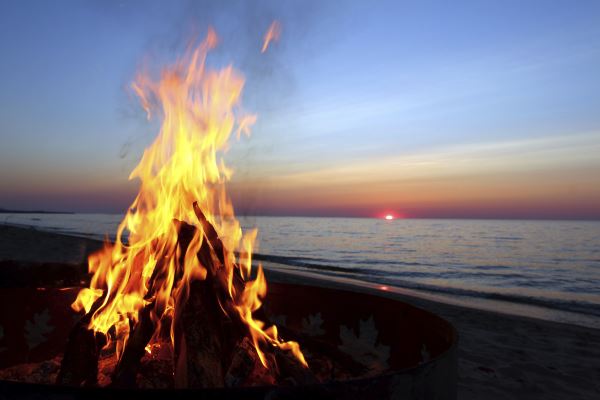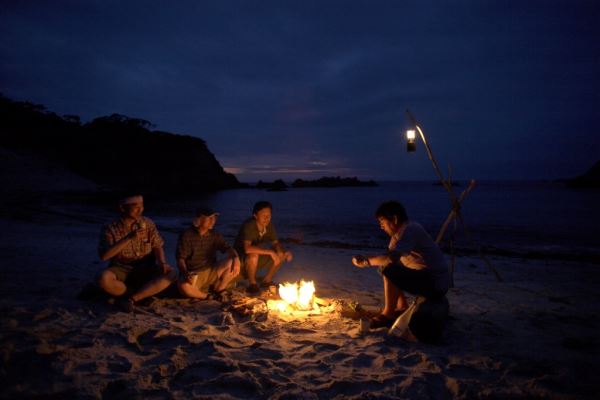
Few things are more fun on a fall night than beaching your boat a quiet beach, browning mallows over a balmy beachside fire, and watching the sparks meld with the stars.
This relaxing merrymaking, of course, revolves around a good campfire. Some of us learn these tricks at Boy Scouts or campouts, but going awhile without lighting a good fire can make you a little rusty. Here are some tips to ensure you can build and maintain the perfect fire for your next nighttime boating venture!
1. Clear a good fire spot at least 10 feet wide.
Remove any leaves, branches, or dry debris so you can start the fire on bare soil. Aim for about 10 feet across when clearing your circle. Make sure to avoid setting up a spot underneath overhanging branches or standing deadwood so rising sparks don’t cause any mischief. You can also build a simple fire ring out of stones and rocks to help contain the fire, and be sure to keep a bucket of water handy.
2. Prepare a hearty supply of smart fuel.
When collecting your fuel, look out for good tinder and kindling. Good tinder can be made out of dry leaves, pine needles, grasses, wood shavings, rolled paper balls, that sort of thing. You can even bring a pencil sharpener and sharpen small sticks to make light, dry shavings instantly. Good kindling can be scrounged from dry twigs and chopped firewood that’s thicker than three inches in diameter.
The tinder and kindling will of course make up the basic foundation of your fire out of fuel that’s light and has a lot of surface area to catch a flame. Gathering too much is much better than too little and running short just when you’re about to get the fire going.
3. Fashion your base.
The two classic types of bases are the tepee and the log cabin. For the teepee style, gather a couple of handfuls of loose tinder in a pile in the center and then set up the kindling vertically around it like a tepee. Once you light the fire, feed it with more branches in that teepee shape, graduating to firewood as the fire grows strong enough to handle it. For the log cabin, set four large logs (about 8 to 10 inches in diameter) in a two- to three-foot square that’s well bedded down. Then stack logs to fashion a short horizontal stack. Fill the center of the square with tinder and kindling. Some variants of the log cabin, like the lean-to method, are easier for novices/kids and will burn wood more slowly, but the teepee is often recommended for its higher burning flames and easy set-up.
 4. Use only dry firewood.
4. Use only dry firewood.
Surprisingly enough, freshly cut wood contains a lot of moisture—up to 50 percent. If steam bubbles and hisses on the fire, your wood is wet or green and will make more smoke, which is always irritating to the eyes when you try to gather close for roasting mallows. Dry wood burns a lot better and cuts significantly down on sharp smoke.
5. Light your fire.
An easy way to light your tinder is to use matches or a lighter from all sides rather than focusing only on one spot. Gently blowing on the fire can get it more oxygen, just be sure not to blow too hard until the flame has caught enough. Never use charcoal lighter fluid or white gas (like Coleman lantern/camp stove gas) to speed up lighting your fire.
6. Keep the fire burning.
As the base logs eventually burn through, move them into the fire’s center and set new logs in place. Be aware of your log supply as you pace your burning throughout the evening. Sometimes in our eagerness to build up a big fire, we run out of wood faster than we plan, and no one is happy to cut s’mores time short.
If you want a smaller blaze, stifle it with a shovelful of ash, dirt, or sand. If you want more fire, add kindling to the top—and don’t put a giant log on at the end of the night or it’ll be a pain to put out. Instead, try to time the fire’s natural resolution for when everyone else is also winding down.
7. Safely put out the fire.
At the night’s end, use a solid poker stick to push what’s left of your tepee or log cabin apart. Gradually pour water and stir everything around until all of the sparks and embers have been snuffed. Remember not to touch the ashes for a few days, since they often retain heat even under cool water and ashy mud. Also remember that warm bed of ash underneath can be helpful if you want to go at round two with a campfire tomorrow.
 8. Watch the weather.
8. Watch the weather.
For the best nighttime fireside experience, check out when the sun sets, when the moon rises, and whether there will be any cloud cover to hide the stars in gauzy layers. If you time your fire-making right, the beachside experience will be beautifully lit up by the heavens as much as your campfire.
For more safety and perfect mallow roasting tips, visit accuweather.com!

